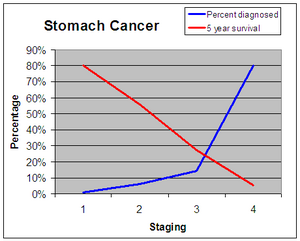Gastric cancer
Definition
Cancer. In the stomach. Hard one to work out that.
Epidemiology
Pretty common - the seventh most common cancer in the UK. Also similar in many ways to colorectal cancer and oesophageal cancer. 95% of cases are in the over 50s.
Risk Factors
- Helicobacter pylori infection
- Smoking
- Family history of GI cancer
- Diet high in salt, low in fruit and vegetables.
- Autoimmune atrophic gastritis
Clinical Features
Gastric cancer typically presents quite late. Whilst usually asymptomatic, early symptoms can include:
- Heartburn or reflux
- Loss of appetite
- Abnormal burping or indigestion
Late symptoms:
- Abdominal pain.
- Abdominal bloating.
- Weight loss.
- Diarrhoea or constipation - any change in bowel habit.
- Nausea and vomiting.
- Bleeding, presenting either as haematemesis, or blood in stool, usually malaena.
- Symptoms of anaemia.
Investigations
Whilst things like a FBC, looking for abnormal white cells, or anaemia are important, the gold standard for investigation is an OGD, or Oesophogastroduodenoscopy - basically, an endoscopy of the upper GI tract.
This can be followed up with CT, to look at invasion into adjacent tissues, and lymph node spread, but ultimately its all about the OGD.
Staging
- Stage 0 - cancer is just in the inner lining of the stomach.
- Stage I - cancer has gone through to the second or third layers of the stomach (Stage 1A) or to the second layer and nearby lymph nodes (Stage 1B).
- Stage II - cancer has penetrated to the second layer and more distant lymph nodes, or the third layer and only nearby lymph nodes, or all four layers but not the lymph nodes.
- Stage III - cancer has penetrated to the third layer and more distant lymph nodes, or penetration to the fourth layer and either nearby tissues or nearby or more distant lymph nodes.
- Stage IV - Cancer has spread to nearby tissues and more distant lymph nodes, or has metastatized to other organs.
Management
It's all about the staging. Only the earlier cancers are fully treatable, through surgical resection. Whilst chemotherapy and radiotherapy can increase longevity, they cannot provide a cure.
Usually surgery will involve complete resection of the stomach, and removal of adjacent lymph nodes. Currently surgery provides about an 60% cure - most stage 4 patients are considered inoperable, but survival is directly linked to stage.
Prognosis
The rather depressing graph at the top shows likely survival rates.
Basically, if you get detected in Stage 1, you have an 80% five year survival rate. However, only 6% of people are caught that early.
If you get detected in Stage 4, which 80% of people are, you have a 5% five year survival rate.
In other words:
- If you get diagnosed late, you are very likely to die.
- The majority of people are diagnosed late.
- The majority of people die.
